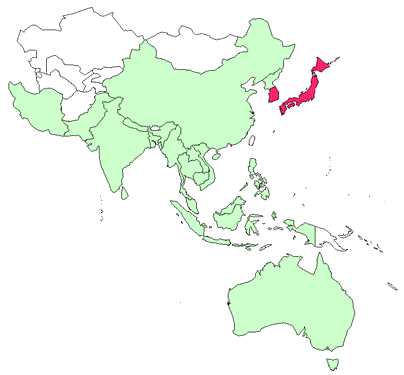Diseases of finfish
Viral diseases—Red sea bream iridoviral disease
Signs of disease
Important: animals with disease may show one or more of the signs below, but disease may still be present in the absence of any signs.
Disease signs at the farm level
- low to high mortality
Disease signs at the tank and pond level
- lethargic
Gross signs of disease in an infected animal
- severe anaemia
- pinpoint haemorrhage of the gills
- enlarged spleen
Disease agent
Red sea bream iridoviral disease (RSIVD) is caused by an unclassified iridovirus and is related to white sturgeon iridoviral disease.
Host range
Fish known to be susceptible to RSIVD:
barramundi* (Lates calcarifer)
black sea bream* (Acanthopagrus schlegeli)
chicken grunt* (Parapristipoma trilineatum)
crimson sea bream* (Evynnis japonica)
estuarine rockcod* (Epinephelus tauvina)
girella, rudderfish* (Girella punctata)
Japanese amberjack* (Seriola quinqueradiata)
Japanese flounder, 'Hirame' strain* (Paralichthys olivaceus)
Japanese horse mackeral* (Trachurus japonicus)
Japanese parrotfish* (Oplegnathus facsiatus)
Japanese sea bass* (Lateolabrax japonicus)
largemouth bass* (Micropterus salmonoides)
Malabar rockcod* (Epinephelus malabaricus)
northern bluefin tuna* (Thunnus thynnus)
red sea bream* (Pagras major)
red-spotted grouper* (Epinephelus akaara)
samson fish* (Seriola hippos)
sea bass* (Lateolabrax spp)
seven-band grouper* (Epinephelus septemfasciatus)
silver trevally* (Pseudocaranx dentex)
six-bar grouper* (Epinephelus sexfasciatus)
snapper/red sea bream* (Pagrus auratus, syn Pagrus major)
snubnose dart* (Trachinotus blochii)
spotted knifejaw* (Oplegnathus punctatus)
tiger puffer* (Takifugu rubripes)
yellow grouper* (Epinephelus awoara)
golden striped amberjack (Seriola lalandi )
* naturally susceptible (other species have been shown to be experimentally susceptible)
Presence in Asia–Pacific

RSIVD has been officially reported from Hong Kong, Japan and the Republic of Korea.
Epidemiology
- RSIVD is highly contagious.
- Mortality is highly variable.
- Transmission is horizontal (that is, via the water column from other infected fish).
Differential diagnosis
The differential diagnostic table and the list of similar diseases appearing at the bottom of each disease page refer only to the diseases covered by this field guide. Gross signs observed might well be representative of a wider range of diseases not included here. Therefore, these diagnostic aids should not be read as a guide to a definitive diagnosis, but rather as a tool to help identify the listed diseases that most closely account for the gross signs.
Similar diseases
Epizootic haematopoietic necrosis
Sample collection
Because of uncertainty in differentiating diseases using only gross signs, and because some aquatic animal disease agents might pose a risk to humans, you should not try to collect samples unless you have been trained. Instead, you should phone your national hotline number and report your observations. If samples have to be collected, the agency taking the call will advise you on what you need to do. Local or district fisheries/veterinary authorities could advise you on sampling.
Emergency disease hotline
For your national emergency disease hotline number, see Whom to contact if you suspect a disease.
Further reading
http://www.oie.int/aac/eng/cards/en_diseasecard.htm
The currently accepted procedures for a conclusive diagnosis of RSIVD are summarised at http://www.oie.int/eng/normes/fmanual/A_00032.htm
These hyperlinks were correct and functioning at the time of publication.

